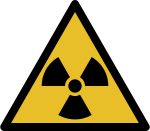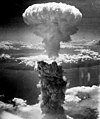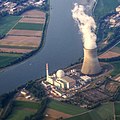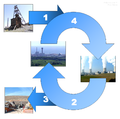Portal:Nuclear technology
The Nuclear Technology Portal
Introduction

- Nuclear technology is technology that involves the nuclear reactions of atomic nuclei. Among the notable nuclear technologies are nuclear reactors, nuclear medicine and nuclear weapons. It is also used, among other things, in smoke detectors and gun sights. (Full article...)
- Nuclear power is the use of nuclear reactions to produce electricity. Nuclear power can be obtained from nuclear fission, nuclear decay and nuclear fusion reactions. Presently, the vast majority of electricity from nuclear power is produced by nuclear fission of uranium and plutonium in nuclear power plants. Nuclear decay processes are used in niche applications such as radioisotope thermoelectric generators in some space probes such as Voyager 2. Reactors producing controlled fusion power have been operated since 1958 but have yet to generate net power and are not expected to be commercially available in the near future. (Full article...)
- A nuclear weapon is an explosive device that derives its destructive force from nuclear reactions, either fission (fission bomb) or a combination of fission and fusion reactions (thermonuclear bomb), producing a nuclear explosion. Both bomb types release large quantities of energy from relatively small amounts of matter. (Full article...)
General images -
Selected article -
All known thorium isotopes are unstable. The most stable isotope, 232Th, has a half-life of 14.05 billion years, or about the age of the universe; it decays very slowly via alpha decay, starting a decay chain named the thorium series that ends at stable 208Pb. On Earth, thorium and uranium are the only elements with no stable or nearly-stable isotopes that still occur naturally in large quantities as primordial elements. Thorium is estimated to be over three times as abundant as uranium in the Earth's crust, and is chiefly refined from monazite sands as a by-product of extracting rare-earth elements.
Thorium was discovered in 1828 by the Norwegian amateur mineralogist Morten Thrane Esmark and identified by the Swedish chemist Jöns Jacob Berzelius, who named it after Thor, the Norse god of thunder and war, because of its power. Its first applications were developed in the late 19th century. Thorium's radioactivity was widely acknowledged during the first decades of the 20th century. In the second half of the century, thorium was replaced in many uses due to concerns about its radioactivity.
Thorium is still being used as an alloying element in TIG welding electrodes but is slowly being replaced in the field with different compositions. It was also material in high-end optics and scientific instrumentation, used in some broadcast vacuum tubes, and as the light source in gas mantles, but these uses have become marginal. It has been suggested as a replacement for uranium as nuclear fuel in nuclear reactors, and several thorium reactors have been built. Thorium is also used in strengthening magnesium, coating tungsten wire in electrical and welding equipment, controlling the grain size of tungsten in electric lamps, high-temperature crucibles, and glasses including camera and scientific instrument lenses. Other uses for thorium include heat-resistant ceramics, aircraft engines, and in light bulbs. Ocean science has utilised 231Pa/230Th isotope ratios to understand the ancient ocean. (Full article...)
Selected picture -
Attribution: The Ames Laboratory, USDOE (http://www.ameslab.gov/)
Did you know?
- ... that poet Peggy Pond Church became a strong pacifist and a member of the Society of Friends after the Manhattan Project used her home as a place to build nuclear weapons?
- ... that Jeya Wilson invited New Zealand prime minister David Lange to debate the moral indefensibility of nuclear weapons at the Oxford Union?
- ... that before becoming a successful children's author, Myron Levoy was an engineer doing research on nuclear-powered spaceships for a mission to Mars?
- ... that Project Ketch proposed the detonation of a 24-kiloton nuclear device in Pennsylvania to create a natural-gas storage reservoir?
- ... that T. K. Jones thought that a nuclear war was survivable if "there are enough shovels to go around"?
- ... that the medieval Castle Knob was the site of a Cold War nuclear monitoring station?
Related WikiProjects
Things you can do
| Parts of this portal (those related to section) need to be updated. Please help update this portal to reflect recent events or newly available information. Relevant discussion may be found on the talk page. (September 2021) |
Selected biography -
A 1922 graduate of the United States Naval Academy, Parsons served on a variety of warships beginning with the battleship USS Idaho. He was trained in ordnance and studied ballistics under L. T. E. Thompson at the Naval Proving Ground in Dahlgren, Virginia. In July 1933, Parsons became liaison officer between the Bureau of Ordnance and the Naval Research Laboratory. He became interested in radar and was one of the first to recognize its potential to locate ships and aircraft, and perhaps even track shells in flight. In September 1940, Parsons and Merle Tuve of the National Defense Research Committee began work on the development of the proximity fuze, an invention that was provided to the US by the UK Tizard Mission, a radar-triggered fuze that would explode a shell in the proximity of the target. The fuze, eventually known as the VT (variable time) fuze, Mark 32, went into production in 1942. Parsons was on hand to watch the cruiser USS Helena shoot down the first enemy aircraft with a VT fuze in the Solomon Islands in January 1943.
In June 1943, Parsons joined the Manhattan Project as Associate Director at the Project Y research laboratory at Los Alamos, New Mexico, under J. Robert Oppenheimer. Parsons became responsible for the ordnance aspects of the project, including the design and testing of the non-nuclear components of nuclear weapons. In a reorganization in 1944, he lost responsibility for the implosion-type fission weapon, but retained that for the design and development of the gun-type fission weapon, which eventually became Little Boy. He was also responsible for the delivery program, codenamed Project Alberta. He watched the Trinity nuclear test from a B-29.
After the war, Parsons was promoted to the rank of rear admiral without ever having commanded a ship. He participated in Operation Crossroads, the nuclear weapon tests at Bikini Atoll in 1946, and later the Operation Sandstone tests at Enewetak Atoll in 1948. In 1947, he became deputy commander of the Armed Forces Special Weapons Project. He died of a heart attack in 1953. (Full article...)
Nuclear technology news
- 14 December 2024 – 2024 New Jersey drone sightings
- The Public Service Enterprise Group files a request with the Federal Aviation Administration to close the airspace over two of its nuclear power plants to all aircraft after unidentified drones were spotted hovering over the facilities in New Jersey. (The New York Post via MSN)
- 10 December 2024 – Belarus–Russia relations, Nuclear risk during the Russian invasion of Ukraine
- Belarusian President Alexander Lukashenko confirms the presence of nuclear weapons in his country, including Russia's Oreshnik missile system. (AP)
- 6 December 2024 – Belarus–Russia relations, Nuclear risk during the Russian invasion of Ukraine
- Russian President Vladimir Putin and Belarusian President Alexander Lukashenko sign an agreement in Minsk, Belarus, offering security guarantees to Belarus including nuclear security and the possible use of Russian nuclear weapons in order to repel aggressions. (AP)
- 1 December 2024 – Ukraine–United States relations
- U.S. National Security Advisor Jake Sullivan says that the United States will not return the nuclear weapons that they dismantled to Ukraine. (Reuters)
Related portals
Related topics
Subcategories
Associated Wikimedia
The following Wikimedia Foundation sister projects provide more on this subject:
-
Commons
Free media repository -
Wikibooks
Free textbooks and manuals -
Wikidata
Free knowledge base -
Wikinews
Free-content news -
Wikiquote
Collection of quotations -
Wikisource
Free-content library -
Wikiversity
Free learning tools -
Wiktionary
Dictionary and thesaurus







































































































